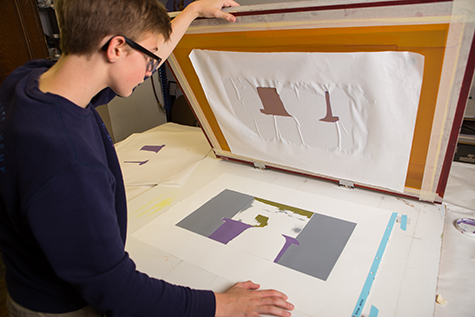The Vital Guide to Recognizing Screen Printing and Its Versatile Makes use of
Screen printing has a rich background that goes back to ancient times, evolving right into an advanced method utilized throughout various sectors today. This guide discovers the intricacies of the screen printing process, describing its applications in fashion, marketing, and home decoration - 10:9 Design Company. Comprehending these fundamentals can open up innovative capacity for both business and creative jobs. The adhering to sections will expose vital tips and methods to enhance one's screen printing ventures
The Background of Screen Printing
Although screen printing has roots that trace back centuries, its advancement shows the creative and technical advancements of different cultures. Coming from ancient China, the strategy was initially used for enhancing fabrics and later infect Japan, where it came to be integral to Ukiyo-e woodblock printing. The approach changed to Europe in the 18th century, where it got appeal among artisans and commercial printers. The invention of picture emulsion in the 20th century revolutionized screen printing, permitting even more elaborate layouts and greater performance. Artists like Andy Warhol better propelled its popularity, utilizing the medium to produce iconic works that mixed commercialism and great art. By the late 20th century, screen printing had actually established itself as a functional technique, used in style, advertising and marketing, and art. Today, it proceeds to evolve, incorporating digital modern technology and expanding its applications throughout different sectors.
The Screen Printing Refine Explained
Screen printing transforms artistic visions into tangible designs via a collection of accurate steps. A picture is created and after that moved onto a screen, usually made of great mesh fabric stretched over a structure. A light-sensitive emulsion is applied to the screen, which is exposed to light, solidifying in areas not covered by the picture. After rinsing the unhardened emulsion, a stencil is developed.
Next, the screen is put over the substratum, whether it be fabric, paper, or an additional product. Ink is after that pushed with the open areas of the stencil using a squeegee, transferring the style onto the substratum below. This procedure can be repeated for several colors, requiring separate displays for every hue. The printed thing is treated making use of warm to assure the ink adheres properly, resulting in a durable, lively design ready for use.
Kinds Of Screen Printing Techniques

Furthermore, specialized strategies, such as discharge screen printing, get rid of dye from the textile to produce softer prints, while aluminum foil screen printing applies metal aluminum foil to attain a glossy coating (10:9 Design LLC Company). Each technique supplies unique qualities, accommodating numerous innovative needs and manufacturing ranges, ultimately expanding the possibilities within the screen printing domain name
Applications of Screen Printing in Various Industries

In addition, the signage and marketing fields use screen printing for developing appealing screens and banners. This technique allows for vibrant shades and complex designs that record attention. In electronics, screen printing is used for applying conductive inks to circuit boards, crucial for component links. The home decoration sector embraces screen printing to create unique designs on textiles and wall art. Overall, screen printing offers as a critical device throughout diverse areas, enhancing products with customized and visually appealing graphics.
Tips for Successful Screen Printing Projects
While embarking on a screen printing project, click this cautious focus to information can considerably boost the last result. Picking top quality materials is essential; this consists of the screen, inks, and substratums. Utilizing ideal mesh matters can affect ink deposition and detail resolution. Prep work is just as essential; complete cleaning of screens and proper direct exposure times guarantee laminated signs online crisp prints.
Next off, exact registration is essential for multi-color prints. Using alignment tools can aid achieve accurate layering. Additionally, screening prints on scrap products before manufacturing aids identify possible concerns without wasting resources.

Regularly Asked Questions
What Products Are Finest for Screen Printing on Fabric?
Cotton and polyester blends are ideal for screen printing on material due to their longevity and ink absorption. In addition, specialty fabrics like silk or canvas can create distinct structures and coatings, enhancing the total style quality.
Just how Do I Tidy and Maintain Screen Printing Tools?
To clean up and maintain screen printing tools, one should consistently wash screens with appropriate solvents, evaluate mops for wear, lubricate moving components, and store all items in a completely dry, dust-free environment to prolong their life-span.
What Are the Ecological Effects of Screen Printing?
Screen printing can have substantial environmental effects, including chemical waste from inks and solvents, water usage during cleansing procedures, and power consumption. Environment-friendly materials and sustainable practices are necessary for reducing these negative results.
Can Screen Printing Be Done in your home Effectively?
Screen printing can be successfully done at home with the ideal materials and strategies. Enthusiasts can create top quality prints, though success depends upon their skill level, devices, and understanding of the process included.
What Are the Prices Connected With Starting a Display Printing Organization?

Starting a screen printing business involves expenses for equipment, products, and office. Initial expenditures commonly range from a few hundred to numerous thousand bucks, relying on the range, quality of equipment, and wanted production capacity.
Screen printing has an abundant background that websites dates back to old times, advancing into an advanced strategy made use of across various industries today. Another strategy, rotary screen printing, employs round displays, promoting constant printing on textile rolls, thereby improving efficiency for large productions. Additionally, specialized techniques, such as discharge screen printing, eliminate color from the fabric to develop softer prints, while foil screen printing uses metal foil to accomplish a glossy surface. In the fashion field, screen printing is commonly utilized to develop dynamic designs on clothing, allowing brand names to showcase their unique styles. Cotton and polyester blends are excellent for screen printing on fabric due to their resilience and ink absorption.